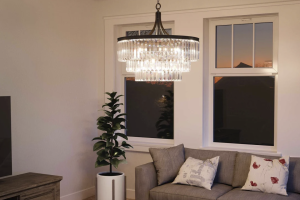Belgium has long been a crucible of artistic innovation, and its design lighting sector is no exception. The roots of Belgian design lighting can be traced back to the early 20th century, a period marked by the rise of Art Nouveau and later, Art Deco movements. During this time, designers began to explore the interplay of form and function, leading to the creation of lighting fixtures that were not only practical but also aesthetically pleasing.
The work of designers like Victor Horta, who was instrumental in the Art Nouveau movement, laid the groundwork for a unique approach to lighting that emphasized organic forms and intricate details. As the decades progressed, Belgian design lighting evolved alongside broader design trends. The mid-20th century saw the emergence of modernism, which brought about a shift towards minimalism and functionality.
Designers such as Gino Sarfatti and Achille Castiglioni began to influence Belgian designers, who sought to create pieces that were stripped of unnecessary ornamentation while still maintaining a strong visual impact. This period also saw the establishment of several design schools and institutions in Belgium, which fostered a new generation of designers who would go on to make significant contributions to the field of lighting design.
The Influence of Belgian Culture on Design
The Emphasis on Craftsmanship
The emphasis on craftsmanship and artisanal techniques can be traced back to Belgium’s historical reputation for high-quality textiles and fine arts. This dedication to quality is evident in the meticulous attention to detail found in Belgian lighting designs, where each piece is often handcrafted with precision.
The Influence of Artistic Traditions
Belgium’s vibrant art scene has played a crucial role in shaping its design landscape. The country has produced numerous influential artists and movements, such as the surrealists and the Flemish primitives. These artistic traditions have inspired designers to experiment with light as a medium for expression.
Pushing Boundaries in Lighting Design
For instance, the use of light Pohuts in contemporary installations often reflects the surrealist fascination with perception and reality. This cultural backdrop encourages designers to push boundaries and explore innovative concepts that challenge conventional notions of lighting.
The Unique Characteristics of Belgian Design Lighting
Belgian design lighting is characterized by its harmonious blend of functionality and artistry. One of the most distinctive features is the emphasis on simplicity combined with elegance. Many Belgian lighting fixtures exhibit clean lines and geometric shapes, yet they possess an inherent warmth that invites interaction.
This balance between minimalism and comfort is a hallmark of Belgian design philosophy, where every element serves a purpose while contributing to an overall aesthetic. Another defining characteristic is the use of materials. Belgian designers often favor natural materials such as wood, metal, and glass, which not only enhance the visual appeal but also contribute to the durability of the pieces.
For example, the combination of warm wood tones with sleek metal finishes creates a striking contrast that elevates the design. Additionally, many designers experiment with textures and finishes, resulting in lighting fixtures that are visually dynamic and engaging from multiple angles.
Famous Belgian Designers in the Lighting Industry
Several Belgian designers have made significant contributions to the lighting industry, each bringing their unique vision and style to the forefront. One notable figure is Maarten Van Severen, whose work is characterized by a minimalist approach that emphasizes functionality without sacrificing aesthetics. His designs often feature clean lines and innovative materials, making them both practical and visually striking.
Van Severen’s lighting pieces are celebrated for their ability to blend seamlessly into various environments while still making a bold statement. Another prominent designer is Philippe Starck, known for his eclectic style that often incorporates humor and whimsy into his creations. Starck’s lighting designs range from sleek and modern to playful and unexpected, showcasing his versatility as a designer.
His work has garnered international acclaim, and he has collaborated with numerous brands to create iconic lighting pieces that are instantly recognizable. Starck’s ability to infuse personality into his designs has made him a significant figure in the world of Belgian lighting.
The Sustainability and Eco-Friendly Approach of Belgian Design Lighting
In recent years, sustainability has become a central theme in design across various industries, including lighting. Belgian designers are increasingly adopting eco-friendly practices, focusing on creating products that minimize environmental impact while maintaining high aesthetic standards. This shift is driven by a growing awareness of climate change and the need for responsible consumption.
Many designers are now prioritizing sustainable materials such as recycled metals and responsibly sourced wood in their creations. Moreover, energy efficiency is a key consideration in Belgian design lighting. The integration of LED technology has revolutionized the industry, allowing designers to create fixtures that consume less energy while providing ample illumination.
This not only reduces electricity costs for consumers but also contributes to lower carbon emissions. By embracing sustainable practices and innovative technologies, Belgian designers are setting a precedent for responsible design that aligns with contemporary values.
How Belgian Design Lighting is Making its Mark on the Global Stage
Global Recognition through International Design Fairs
International design fairs such as Milan Design Week have showcased Belgian lighting brands, allowing them to reach a broader audience and establish their presence in competitive markets.
Authenticity and Craftsmanship
The distinctiveness of Belgian design—marked by its emphasis on craftsmanship and innovative use of materials—has resonated with consumers seeking authenticity in their home decor.
Collaborations and Limited-Edition Collections
Furthermore, collaborations between Belgian designers and international brands have further amplified their influence. These partnerships often result in limited-edition collections that highlight the strengths of both parties while introducing Belgian aesthetics to new markets. As a result, Belgian design lighting is increasingly sought after by collectors and enthusiasts worldwide, solidifying its status as a significant player in the global design landscape.
The Future of Belgian Design Lighting
The future of Belgian design lighting appears promising as designers continue to explore new technologies and materials while remaining committed to their cultural roots. The integration of smart technology into lighting solutions is one area poised for growth. As homes become more connected through smart devices, there is an increasing demand for lighting that can be controlled remotely or programmed for specific moods and activities.
Belgian designers are well-positioned to innovate in this space, combining their artistic sensibilities with cutting-edge technology. Additionally, there is a growing trend towards personalization in design. Consumers are increasingly looking for unique pieces that reflect their individual tastes and lifestyles.
This shift presents an opportunity for Belgian designers to create customizable lighting solutions that cater to diverse preferences while maintaining their signature style. By embracing these trends, Belgian design lighting can continue to evolve and thrive in an ever-changing market.
Where to Find and Purchase Authentic Belgian Design Lighting
For those interested in acquiring authentic Belgian design lighting, several avenues exist that cater specifically to this niche market. High-end design showrooms in major cities often feature collections from renowned Belgian designers, providing an opportunity to experience the craftsmanship firsthand. These showrooms typically offer a curated selection of pieces that highlight both contemporary designs and classic works.
Online platforms have also emerged as valuable resources for purchasing authentic Belgian lighting. Websites dedicated to design furniture often feature sections specifically for Belgian brands, allowing consumers from around the world to access these unique pieces with ease. Additionally, attending international design fairs can provide insights into emerging trends while offering direct access to designers and manufacturers who specialize in Belgian lighting.
In conclusion, Belgium’s rich history in design lighting reflects its cultural heritage and commitment to craftsmanship. As this sector continues to evolve, it remains firmly rooted in its unique characteristics while embracing sustainability and innovation. With renowned designers leading the charge and an increasing global presence, Belgian design lighting is poised for a bright future on the international stage.



